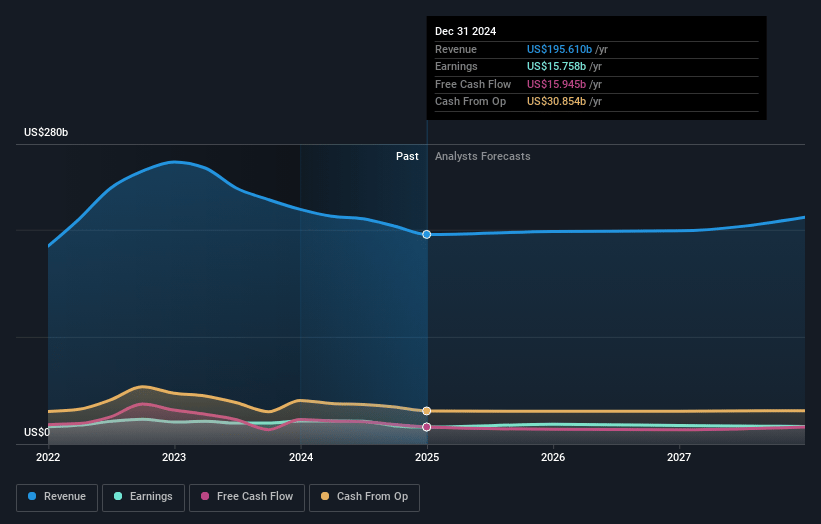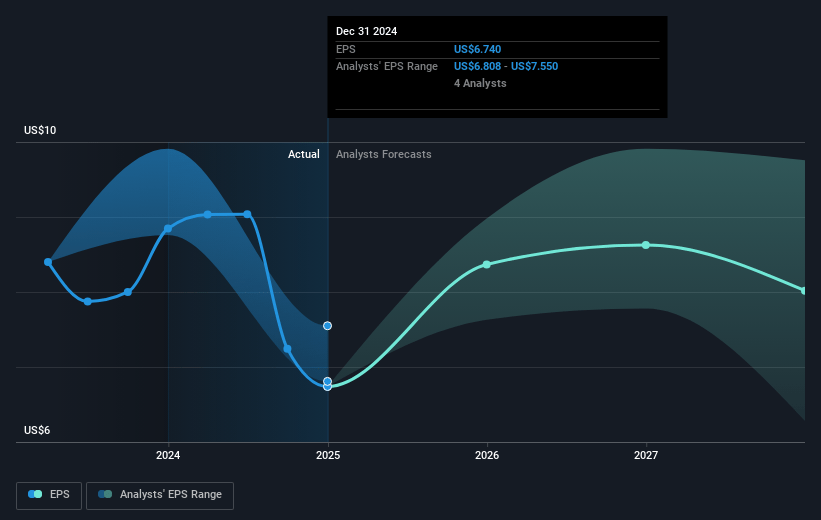Key Takeaways
- TotalEnergies' strong low-cost, low-emissions oil and gas portfolio enhances cash flow and production growth, boosting earnings stability.
- Strategic electricity expansion and efficient capital allocation underpin diversified revenue streams, appealing to investors and stabilizing earnings.
- Geopolitical uncertainties and market volatility could pressure TotalEnergies' earnings and cash flow, necessitating strategic adjustments and impacting shareholder returns.
Catalysts
About TotalEnergies- A multi-energy company, produces and markets oil and biofuels, natural gas, biogas and low-carbon hydrogen, renewables, and electricity in France, rest of Europe, and internationally.
- TotalEnergies is leveraging its strong low-cost, low-emissions oil and gas portfolio to sustain robust cash flows and drive production growth, contributing to improved earnings and revenue stability.
- Expansion in electricity production, with a 18% increase in the first quarter, offers resilience against oil price volatility, supporting diverse revenue streams and potentially enhancing margins by stabilizing earnings.
- The company maintains cost efficiency, with CapEx controlled through lump sum EPC contracts and OpEx kept under $5 per barrel, promoting better net margins and consistent cash flow outcomes.
- TotalEnergies plans to deliver growth through new high-margin oil projects like Ballymore in the U.S. and Mero-4 in Brazil, potentially increasing revenue and contributing to cash flow accretion.
- TotalEnergies continues its strong capital allocation strategy, with an increasing interim dividend and ongoing share buybacks, supporting EPS growth and appealing to investors while maintaining a strong balance sheet.
TotalEnergies Future Earnings and Revenue Growth
Assumptions
How have these above catalysts been quantified?- Analysts are assuming TotalEnergies's revenue will decrease by 0.2% annually over the next 3 years.
- Analysts assume that profit margins will shrink from 8.1% today to 7.9% in 3 years time.
- Analysts expect earnings to reach $15.6 billion (and earnings per share of $7.84) by about May 2028, down from $15.8 billion today. However, there is a considerable amount of disagreement amongst the analysts with the most bullish expecting $17.8 billion in earnings, and the most bearish expecting $13.0 billion.
- In order for the above numbers to justify the analysts price target, the company would need to trade at a PE ratio of 11.4x on those 2028 earnings, up from 8.2x today. This future PE is lower than the current PE for the US Oil and Gas industry at 16.4x.
- Analysts expect the number of shares outstanding to decline by 4.12% per year for the next 3 years.
- To value all of this in today's terms, we will use a discount rate of 6.86%, as per the Simply Wall St company report.
TotalEnergies Future Earnings Per Share Growth
Risks
What could happen that would invalidate this narrative?- The current geopolitical uncertainties, such as the ongoing Ukrainian-Russian conflict and the fluid tariff policies enacted by the U.S., can create volatility and unpredictability in oil and gas markets, potentially impacting TotalEnergies' revenue and cash flow.
- OPEC+'s decision to unwind voluntary production cuts, along with uncertainties around global oil demand, may lead to price fluctuations that could adversely affect TotalEnergies' earnings.
- Tariff impacts on project costs, particularly in the U.S., could increase expenses and pressure net margins, especially if tariffs are applied to imports for significant projects.
- The volatile and uncertain macroeconomic environment, alongside lower oil price scenarios, may require TotalEnergies to adjust its spending or dividend policies, potentially impacting shareholder returns and company valuation.
- Operational issues, such as those reported at the Donges and Port Arthur refineries, can negatively impact cash flow and refining margins, presenting risks to TotalEnergies' profit stability.
Valuation
How have all the factors above been brought together to estimate a fair value?- The analysts have a consensus price target of €65.334 for TotalEnergies based on their expectations of its future earnings growth, profit margins and other risk factors. However, there is a degree of disagreement amongst analysts, with the most bullish reporting a price target of €81.64, and the most bearish reporting a price target of just €55.06.
- In order for you to agree with the analyst's consensus, you'd need to believe that by 2028, revenues will be $197.0 billion, earnings will come to $15.6 billion, and it would be trading on a PE ratio of 11.4x, assuming you use a discount rate of 6.9%.
- Given the current share price of €51.16, the analyst price target of €65.33 is 21.7% higher.
- We always encourage you to reach your own conclusions though. So sense check these analyst numbers against your own assumptions and expectations based on your understanding of the business and what you believe is probable.
How well do narratives help inform your perspective?
Disclaimer
Warren A.I. is a tool utilizing a Large Language Model (LLM) that ingests data on consensus price targets, forecasted revenue and earnings figures, as well as the transcripts of earnings calls to produce qualitative analysis. The narratives produced by Warren A.I. are general in nature and are based solely on analyst data and publicly-available material published by the respective companies. These scenarios are not indicative of the company's future performance and are exploratory in nature. Simply Wall St has no position in the company(s) mentioned. Simply Wall St may provide the securities issuer or related entities with website advertising services for a fee, on an arm's length basis. These relationships have no impact on the way we conduct our business, the content we host, or how our content is served to users. The price targets and estimates used are consensus data, and do not constitute a recommendation to buy or sell any stock, and they do not take account of your objectives, or your financial situation. Note that Warren A.I.'s analysis may not factor in the latest price-sensitive company announcements or qualitative material.




